When creating a successful dining establishment, restaurant interior design plays a crucial role in shaping the customer experience. A well-designed space can elevate the dining experience, while poor design choices can lead to customer dissatisfaction and ultimately impact your bottom line. In this article, we’ll explore common restaurant design mistakes to avoid, ensuring your establishment stands out for all the right reasons.
Overlooking the Importance of Lighting
One of the most critical aspects of restaurant design is lighting. Poor lighting can ruin even the most exquisite culinary creations. Harsh, overly bright lights can make diners feel uncomfortable and exposed, while dim lighting might strain their eyes and make it difficult to read menus. Strive for a balance that complements your restaurant’s ambiance and enhances the dining experience.
Consider using a combination of ambient, task, and accent lighting to create depth and interest. Dimmable lights allow you to adjust the atmosphere throughout the day, catering to different meal services and occasions.
Ignoring Acoustics
A noisy restaurant can be a major turnoff for diners seeking a relaxing meal or intimate conversation. Hard surfaces like concrete floors, bare walls, and metal fixtures can amplify sound, creating an uncomfortably loud environment. Incorporate sound-absorbing materials such as carpets, curtains, or acoustic panels to manage noise levels effectively.
Cramming Too Many Tables
While maximizing seating capacity might seem like a good idea for increasing revenue, overcrowding your dining area can lead to a claustrophobic atmosphere and poor traffic flow. Ensure there’s adequate space between tables for comfortable movement and privacy. Remember, diners value their personal space and may avoid return visits if they feel cramped.
Neglecting the Restroom Design
Often overlooked, restrooms are an essential part of the dining experience. A dirty, poorly maintained, or outdated restroom can leave a lasting negative impression on customers. Invest in clean, well-designed restrooms that align with your restaurant’s overall aesthetic. Consider adding thoughtful touches like high-quality hand soap, proper lighting, and fresh flowers to elevate the experience.
Failing to Create a Cohesive Theme
A mishmash of design elements can confuse customers and dilute your brand identity. Ensure your restaurant’s design aligns with your cuisine, target audience, and overall concept. From the furniture and artwork to the tableware and staff uniforms, every element should contribute to a cohesive theme that tells your restaurant’s unique story.
Overlooking Functionality for Aesthetics
While a visually stunning design is important, it shouldn’t come at the cost of functionality. Ensure your layout allows for efficient service, with clear pathways for staff and customers. Consider the workflow of your kitchen and bar areas to minimize bottlenecks and optimize operations. Click here to learn more about balancing aesthetics and functionality in restaurant design.
Neglecting Outdoor Spaces
If your restaurant has the potential for outdoor seating, take notice of this valuable asset. A well-designed patio or sidewalk cafe can significantly increase your seating capacity and appeal to customers who enjoy al fresco dining. Ensure your outdoor space is comfortable, protected from the elements, and seamlessly integrated with your indoor design.
Forgetting About Accessibility
Designing an inclusive space that accommodates all customers, including those with disabilities, is not just a legal requirement but also good business practice. Ensure your restaurant has proper ramps, wide doorways, accessible restrooms, and clear pathways for wheelchairs. Consider the needs of visually impaired customers by providing menus in Braille or large print.
Conclusion
Avoiding these common restaurant design mistakes can help create a more inviting, functional, and memorable dining experience for your customers. Remember that good design goes beyond aesthetics – it enhances the overall dining experience, supports efficient operations, and contributes to your restaurant’s success. Explore the impact of interior design on restaurant success to further refine your approach to creating the perfect dining environment.
By carefully considering every aspect of your restaurant’s design, from lighting and acoustics to layout and functionality, you can create a space that delights customers and keeps them coming back for more. Invest the time and resources necessary to craft a well-designed restaurant, and you’ll reap the rewards of increased customer satisfaction and loyalty.





